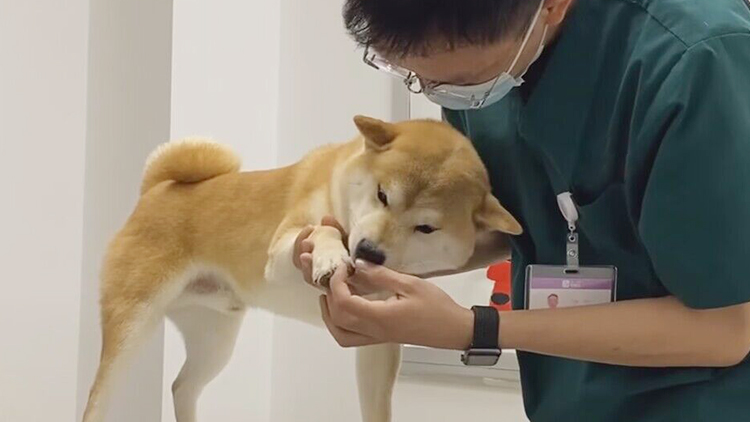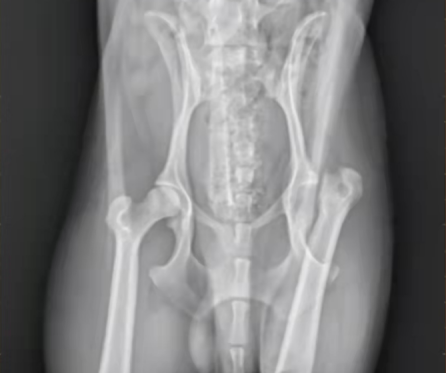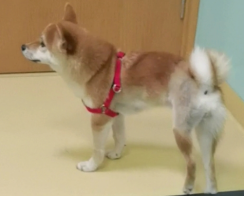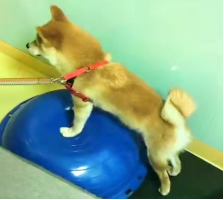
2023-05-31 3056
Abstract:
After the femoral neck fracture, the canine was still lame and unwilling to walk for a long time. He went to our hospital for therapy management, and came to the hospital for laser treatment and rehabilitation exercise 2-3 times a week. The laser effect was significant and the gait tended to be normal.
Key words: laser treatment, fracture, pain relief
1.Case presentation:
NAME: Simpli
SPECIES: Canine
GENDER: Male
AGE: 1
WEIGHT: 6.3kg
The canine because of the acute pneumothorax, lung contusion, femoral neck fracture to the hospital for intensive care management, for symptom relief after fracture repair surgery, postoperative only do simple ice compress and basic rehabilitation then home rest, 2 weeks back to hospital visit line limb still reluctant to walk, and the symptoms of muscle atrophy, the rest of the good mental state, is normal. There was no past existing medical history.
2. Examination
Physical examination: left hind limb hanging lamp, pressing pain, normal heart sound, normal skin and hair. On neurological examination, the hind limb body was normal and the geniculate reflex was normal. Imaging examination showed no significant abnormalities in the left hindlimb surgery area.

3.Diagnosis
Posterior limb lameness due to postoperative pain
4.Treatment
4.1Treatment idea
Simpli still limp after surgery is largely caused by pain. As an emerging technology, there are many studies to prove that laser can mobilize the cells of the body to achieve pain relief and anti-inflammatory effect through the biological effect of light, which is more suitable for the symptoms of this case. Muscle atrophy and unwalking can help exercise and recover through weight transfer and hurdle training.
4.2 Treatment plan
The owner chose the non-hospital mode, so he decided to come to the hospital the next day. A month-long physiotherapy operation was formulated, due to the owner's free time is uncertain, the initial set is 2-3 times a week. Drug: Carprofen (25mg) 1tab po sid once other day, halved one week, and then stopped.
4.2.1 Operation
According to the situation of the dog, choose the rehabilitation project, which is roughly the basic joint stretching, 8-word training, peanut ball training, balance plate training, shaking plate, weight transfer training, hurdle training, etc.
4.2.2 Laser Therapy
This case was treated with LUNVET 4 wavelength laser with preset method:dog-musculoskeletal-joint-hip-light-chronic-8-14KG; considering hip as deep bone tissue, the recommended dose is 6-12J / cm² and average power is 6-10W,using a 25mm contact probe, contact irradiation, uniformly and around the femoral fracture site.The first two weeks is 3 times a week, and then the host schedule is adjusted to 1-2 times a week. The total treatment period was 9 times in 1 month.
4.2.3 Treatment process
The first treatment |
Standing refused to strike the ground, gait limp, give laser and rehabilitation |
The third treatment |
Gait walking when the limbs weight-bearing, but still unwilling to stand on the ground, laser and rehabilitation treatment. |
The fourth treatment |
At the same time, the laser treatment can strengthen the weight bearing of the affected limb and the left weight transfer training. At the same time, the healthy side limb is bandaged to increase the discomfort and enhance the utilization rate of the affected limb. |
The fifth treatment |
Laser and rehabilitation treatment, during the hospital treatment while standing without lameness, the main said at home when walking the dog gait is ok, but still from time to time when standing at home limeness. |
The Seventh treatment |
Light and rehabilitation treatment, gait is OK, add peanut ball, the chief said no limp at home. |
The ninth treatment |
Laser and rehabilitation treatment, strengthen the training, the gait tends to be normal, inform the owner can come to the hospital for 2-3 weeks for consolidated rehabilitation training and laser treatment. |


*Comparison before and after laser treatment
5.Summary
5.1 Without the intervention of appropriate pain management and rehabilitation training, the whole postoperative recovery period may become longer due to pain or muscle atrophy, and even some animals will form a inertial limp state due to pain. The animal sought the help of rehabilitation therapy and, together with laser treatment, significantly accelerated the gait recovery of the affected limb.
5.2 About the whole treatment process, the animal is very cooperate, for laser contact irradiation is not too conflict, rehabilitation training is also very obey instructions, which makes the whole treatment process is very smooth, gait has obvious improvement, the host attitude from the beginning also try to attitude to our treatment results, it is a encouraging thing for our whole treatment team.
5.3 The traditional postoperative management and treatment method of orthopedic surgery is routine pain relief and home rest, but it may cause the pet to be unwilling to walk due to pain, and the symptoms of muscle atrophy and claudication appear in this case. As an emerging technology, laser has non-traumatic and non-painful characteristics, which greatly improves the acceptance of small animals, can bring high quality treatment welfare to animals, and become an advantage to improve the reputation of hospitals. Conventional treatment is feasible, but adding laser to perform pain management in animals can achieve better therapeutic results.
6. Discuss
Animal models have demonstrated that Laser Therapy can increase bone mineralization, and it regulates growth factors that stimulate the morphology of osteogenic cells. These tissues will have more numbers of active osteoblasts, and they will secrete more collagen matrix, so LT can help fracture and osteotomy heal faster and produce organized and less vigorous callus.When we use Laser Therapy in fractures, the goal is to enhance the biological processes that contribute to bone healing. During this process, laser treatment can affect growth factor release, promote blood vessel formation, plan osteoblast activity, and regulate inflammation. Research and experience have demonstrated the importance of protecting tissue and blood supply to the biology of fractures, and that Laser Therapy contributes to this.Laser treatment can reduce neutrophils in joint fluid, increase the release of endorphins to relieve pain, promote blood circulation and lymphatic circulation, and increase joint range of motion, using the body's own healing ability to produce healthier tissues.If the case is treated with laser from the beginning and combined with rehabilitation treatment, the postoperative recovery time and bone healing time can be greatly shortened. Because laser has the effect of promoting injury healing, relieving pain and anti-inflammatory effects, not only can be applied to bone tissue and deep muscle tissue, but also can be used in superficial surface tissue, such as skin damage, dental diseases, soft tissue organs such as pneumonia, gastroenteritis, etc.On the whole, laser, as an auxiliary treatment, is convenient to use, with wide application range and obvious curative effect. It is an advanced technology worthy of clinical application for pets.
Reference paper:Redondo MS,Stephens BJ(2019),Veterinary Laser therapy in Small Animal Practice,(pp.114-121).5M Publishing Ltd.